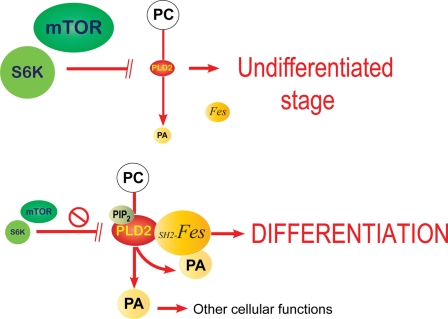FIGURE 10.
Model highlighting the biological significance of findings in this study. mTOR/S6K are highly expressed in undifferentiated cells and keep PLD2 levels at a minimum. Conversely, when levels of mTOR/S6K are low, PLD2 is de-repressed and PLD2 itself takes part in the drive to differentiation. A PLD2-led differentiation uses the Fes kinase pathway to mediate its effects, which is fully functional due to the stimulation of PA and positive feedback by PIP2. This is the first report that has established a sequential link between mTOR/S6K de-repression, PLD2 expression, and Fes activation as fundamental for myeloid differentiation. Understanding the molecular mechanism that drives (and even hastens) differentiation could have beneficial consequences for the treatment of patients with acute promyelocytic leukemias subjected to chemotherapy after differentiation induction.

